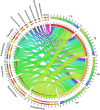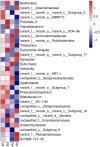Arsenic Transformation in Soil-Rice System Affected by Iron-Oxidizing Strain (Ochrobactrum sp.) and Related Soil Metabolomics Analysis
- PMID: 35256871
- PMCID: PMC8897285
- DOI: 10.3389/fmicb.2022.794950
Arsenic Transformation in Soil-Rice System Affected by Iron-Oxidizing Strain (Ochrobactrum sp.) and Related Soil Metabolomics Analysis
Abstract
Iron-oxidizing bacteria (FeOB) could oxidize Fe(II) and mediate biomineralization, which provides the possibility for its potential application in arsenic (As) remediation. In the present study, a strain named Ochrobactrum EEELCW01 isolated previously, was inoculated into paddy soils to investigate the effect of FeOB inoculation on the As migration and transformation in paddy soils. The results showed that inoculation of Ochrobactrum sp. increased the proportion of As in iron-aluminum oxide binding fraction, which reduced the As bioavailability in paddy soils and effectively reduced the As accumulation in rice tissues. Moreover, the inoculation of iron oxidizing bacteria increased the abundance of KD4-96, Pedosphaeraceae and other bacteria in the soils, which could reduce the As toxicity in the soil through biotransformation. The abundance of metabolites such as carnosine, MG (0:0/14:0/0:0) and pantetheine 4'-phosphate increased in rhizosphere soils inoculated with FeOB, which indicated that the defense ability of soil-microorganism-plant system against peroxidation caused by As was enhanced. This study proved that FeOB have the potential application in remediation of As pollution in paddy soil, FeOB promotes the formation of iron oxide in paddy soil, and then adsorbed and coprecipitated with arsenic. On the other hand, the inoculation of Ochrobactrum sp. change soil microbial community structure and soil metabolism, increase the abundance of FeOB in soil, promote the biotransformation process of As in soil, and enhance the resistance of soil to peroxide pollution (As pollution).
Keywords: arsenic; iron-oxidizing bacteria; metabolomics; microbial community; paddy soil.
Copyright © 2022 Qian, Wu, Pan, Xiong, Xia and Li.
Conflict of interest statement
The authors declare that the research was conducted in the absence of any commercial or financial relationships that could be construed as a potential conflict of interest.
Figures










Similar articles
-
Arsenic biotransformation genes and As transportation in soil-rice system affected by iron-oxidizing strain (Ochrobactrum sp.).Environ Pollut. 2022 Dec 1;314:120311. doi: 10.1016/j.envpol.2022.120311. Epub 2022 Sep 28. Environ Pollut. 2022. PMID: 36181941
-
Remediation of arsenic-contaminated paddy field by a new iron oxidizing strain (Ochrobactrum sp.) and iron-modified biochar.J Environ Sci (China). 2022 May;115:411-421. doi: 10.1016/j.jes.2021.08.009. Epub 2021 Aug 28. J Environ Sci (China). 2022. PMID: 34969469
-
Effects of Fe-oxidizing bacteria (FeOB) on iron plaque formation, As concentrations and speciation in rice (Oryza sativa L.).Ecotoxicol Environ Saf. 2020 Mar 1;190:110136. doi: 10.1016/j.ecoenv.2019.110136. Epub 2020 Jan 2. Ecotoxicol Environ Saf. 2020. PMID: 31901806
-
Vertical distribution of arsenic and bacterial communities in calcareous farmland amending by organic fertilizer and iron-oxidizing bacteria: Field experiment on concomitant remediation.J Hazard Mater. 2024 Jun 5;471:134415. doi: 10.1016/j.jhazmat.2024.134415. Epub 2024 Apr 24. J Hazard Mater. 2024. PMID: 38677113
-
Remediation of arsenic-contaminated calcareous agricultural soils by iron-oxidizing bacteria combined with organic fertilizer.Environ Sci Pollut Res Int. 2023 Jun;30(26):68258-68270. doi: 10.1007/s11356-023-27217-5. Epub 2023 Apr 29. Environ Sci Pollut Res Int. 2023. PMID: 37119488
Cited by
-
Brucella pituitosa strain BU72, a new hydrocarbonoclastic bacterium through exopolysaccharide-based surfactant production.Int Microbiol. 2025 Feb;28(2):299-313. doi: 10.1007/s10123-024-00540-8. Epub 2024 Jun 12. Int Microbiol. 2025. PMID: 38867105
-
Soil metabolomics: Deciphering underground metabolic webs in terrestrial ecosystems.Eco Environ Health. 2024 Mar 20;3(2):227-237. doi: 10.1016/j.eehl.2024.03.001. eCollection 2024 Jun. Eco Environ Health. 2024. PMID: 38680731 Free PMC article. Review.
-
Continuous planting American ginseng (Panax quinquefolius L.) caused soil acidification and bacterial and fungal communities' changes.BMC Microbiol. 2024 Nov 13;24(1):473. doi: 10.1186/s12866-024-03616-7. BMC Microbiol. 2024. PMID: 39538174 Free PMC article.
-
Transcriptomics, proteomics, and metabolomics interventions prompt crop improvement against metal(loid) toxicity.Plant Cell Rep. 2024 Feb 27;43(3):80. doi: 10.1007/s00299-024-03153-7. Plant Cell Rep. 2024. PMID: 38411713 Free PMC article. Review.
References
-
- Alam R., McPhedran K. (2019). Applications of biological sulfate reduction for remediation of arsenic. Chemosphere 222 932–944. 10.1016/j.chemosphere.2019.01.194 - DOI
LinkOut - more resources
Full Text Sources
Research Materials

